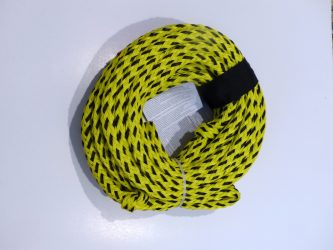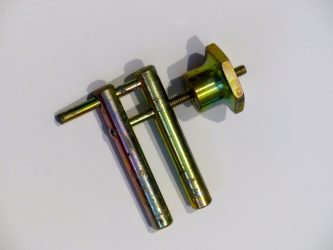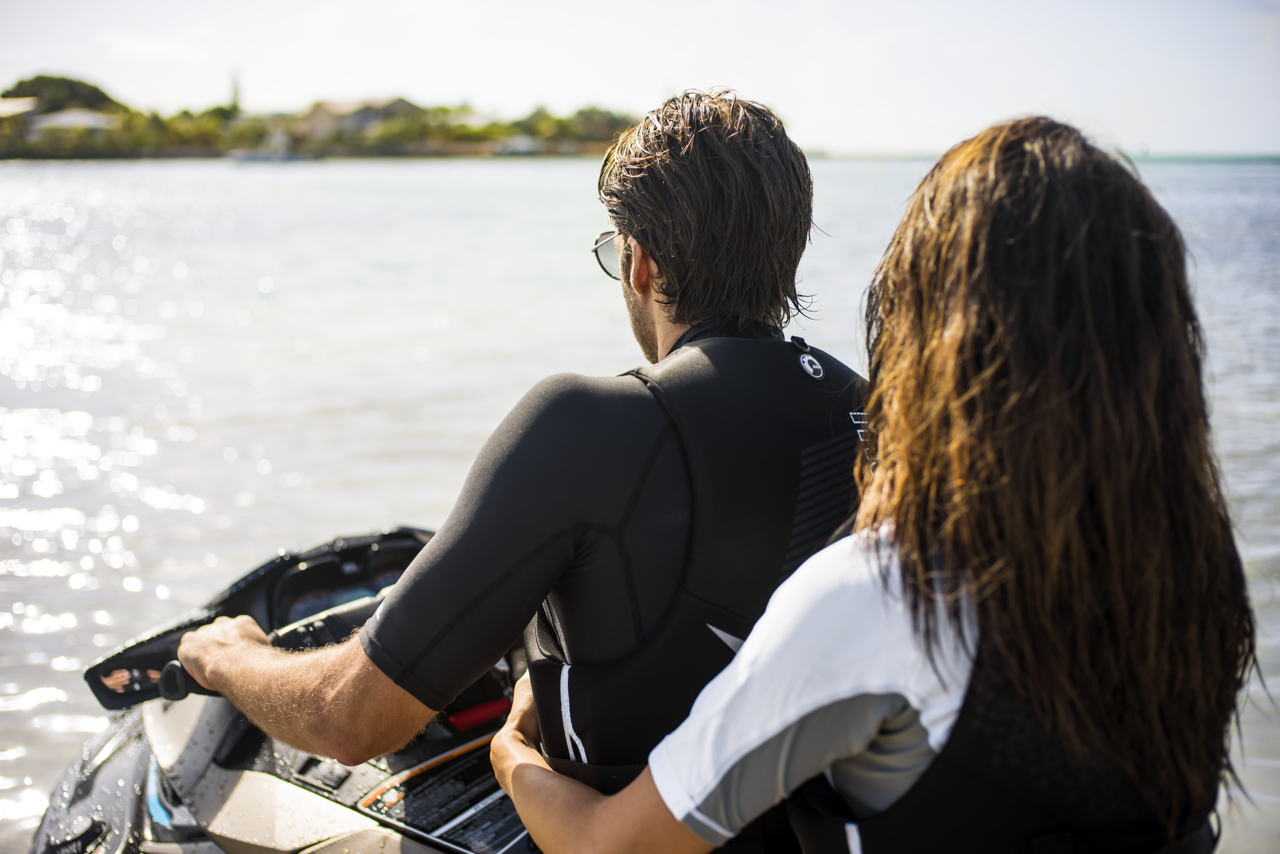How To Tow A Broken PWC…
Related: 5 Common Breakdowns
Your Sea Doo, jet ski or waverunner personal watercraft dies in the water for whatever reason. And you can’t get it started again. So whether you’re an experienced jet ski rider, PWC beginner or renter, that’s when you’ll need my jet ski towing tips to get you home from your Sea Doo tour or PWC adventure…
Depending on what’s wrong and what error code is activated, you may be lucky enough to have your Sea Doo go into what’s called “limp home mode” (reduced RPMs to protect the engine). I think it’s called that because you could swim faster. Otherwise, you’ll have two choices. One, tow your stranded jet ski to the nearest shore (Have you ever tried to paddle a PWC or push it by swimming?). And then leave it while you double up with a companion to go back for your PWC trailer. Or two, you’ll have to tow it all the way back. But if that tow is for any significant distance, hopefully, you’ve come well prepared with emergency tools…
Jet Ski Towing Tips – Towrope Specs
 The first of my jet ski towing tips is that you need a strong, non-stretch towrope (not one made for tow sports). Or a webbed nylon tow strap. I ordered my towrope from the Rope Store. Ideally, use a floating rope. It’s much less likely to get sucked into the intake grate of the towing jetski. And I can’t emphasize enough the need for strong. Under tow, that rope is as taught as a bow string. If it snaps, there’s real danger of injury or damage as it whips forward like a stone from a slingshot.
The first of my jet ski towing tips is that you need a strong, non-stretch towrope (not one made for tow sports). Or a webbed nylon tow strap. I ordered my towrope from the Rope Store. Ideally, use a floating rope. It’s much less likely to get sucked into the intake grate of the towing jetski. And I can’t emphasize enough the need for strong. Under tow, that rope is as taught as a bow string. If it snaps, there’s real danger of injury or damage as it whips forward like a stone from a slingshot.
Whatever you use for towing needs to be long enough (at least 15’) to allow a safety zone between the towing and towed craft. I carry one with metal snap hooks. They’re rated to handle the dead weight being towed and already securely attached to both ends. These quickly and easily hook through the bow eye of the towed unit. And then to the ski tow eye at the rear of the towing PWC. If you don’t have snap hooks already attached, make sure you allow an extra 18” or so at each end of your rope. You’ll need this for tying on to both jetskis (and good luck getting the knots undone after the tow’s finished). Just be sure the knots are boy scout specs to avoid sudden whiplash from a rope that suddenly comes undone.
Jet Ski Towing Tips – Special Precautions
 My next of my jet ski towing tips is that towing a stranded PWC requires special precautions. You need to prevent the exhaust system from filling up with water that gets into the engine and to avoid hydrolock. So you’ve got to tow under the maximum towing speed recommended in your owner’s manual (it seems to range from 10 kph [6mph] to 24 kph [15 mph] depending on make and model). Alternatively, you can clamp off the cross over hose to prevent water intrusion while towing faster. Sea Doo makes a special clamp for doing this. I highly recommend that you have your dealer show you which hose to clamp. And mark it with a piece of coloured duct tape so you can find it again easily in an emergency.
My next of my jet ski towing tips is that towing a stranded PWC requires special precautions. You need to prevent the exhaust system from filling up with water that gets into the engine and to avoid hydrolock. So you’ve got to tow under the maximum towing speed recommended in your owner’s manual (it seems to range from 10 kph [6mph] to 24 kph [15 mph] depending on make and model). Alternatively, you can clamp off the cross over hose to prevent water intrusion while towing faster. Sea Doo makes a special clamp for doing this. I highly recommend that you have your dealer show you which hose to clamp. And mark it with a piece of coloured duct tape so you can find it again easily in an emergency.
Another of my jet ski towing tips is to use a short rope for slow speeds. This way, the wake from the towing craft won’t bounce the stranded jetski around very much. But if you want to tow at a higher speed with have the proper hose clamped, my experience suggests that keeping it stable takes a good 40’ of towrope, This length allows the towed PWC to be far enough behind to stay out of any turbulence created behind the powered up towing craft. Depending on where you are, this much space between craft could be dangerous. What if other waterway users don’t see the towrope and try to pass between the PWCs? Also, any turns have to be very wide so the towed PWC doesn’t end up hitting the shore or some bridge abutment.
Jet Ski Towing Tips – Safety Concerns
Short rope or long, be aware of tow-specific safety concerns. Always keep an eye out for other vessels that won’t know you’re in tow. If possible, have other jetskis ride along to warn others. At the very least have the operator of the stranded PWC ready to give warning signals, maybe by waving a bright cloth or shirt. The operator of the towing jetski needs to be very aware and careful to anticipate and avoid what’s happening ahead. Also, don’t make any sudden manoeuvres. And allow plenty of stopping time to avert being rear-ended by the towed craft.
For these reasons and because it’s always good to have a spotter riding shotgun, I recommend that the operator of the stranded PWC ride double behind the operator of the towing jet ski. I’ve been on a towed watercraft and it’s a pretty helpless feeling. No power, no steering, no brake. All the while getting bounced around like a fishing bobber in a tsunami. And with no way to communicate quickly with the tow operator way out front if something’s going wrong.
If you’ve been methodical and careful about setting up and executing your tow, you should make it where you need to go eventually and safely. But your planned time line for the day will likely be being pretty much shot. So remember to call whoever’s expecting you to advise of your new ETA.
Jet Ski Towing Tips – Also Good For Big Boats Towing PWCs
 Here’s a closing thought when it comes to my jet ski towing tips. Much of the advice provided here should also be helpful to owners of larger boats who want to tow a perfectly healthy personal watercraft behind them for fun and transportation. In this case, I’ve come across two devices that might be helpful, the Towdster and the Magic Marine Tow. Unfortunately, both are too big and unwieldy to carry on a PWC. But might they just do the trick to make towing behind a big boat easier.
Here’s a closing thought when it comes to my jet ski towing tips. Much of the advice provided here should also be helpful to owners of larger boats who want to tow a perfectly healthy personal watercraft behind them for fun and transportation. In this case, I’ve come across two devices that might be helpful, the Towdster and the Magic Marine Tow. Unfortunately, both are too big and unwieldy to carry on a PWC. But might they just do the trick to make towing behind a big boat easier.
Check out my favourite Sea-Doo rides!
If you enjoyed this post, check out my other riding tips.
The tips and advice in this article are the opinions of the author, may not work in every situation and are intended only for the convenience and interest of the reader, who has the personal responsibility to confirm the validity, accuracy and relevancy of this information prior to putting it to their own use.

